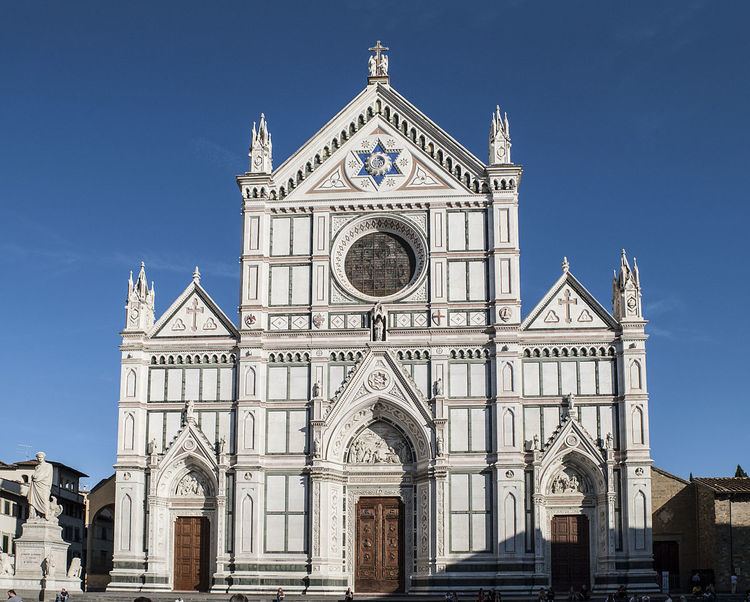Denomination Roman Catholic Status Minor basilica Construction started 1296 | Country Italy Consecrated 1443 | |
 | ||
Architectural styles Gothic architecture, Gothic Revival architecture, Renaissance architecture, Italian Gothic architecture Similar Florence Cathedral, Ponte Vecchio, Piazza della Signoria, Uffizi Gallery, Santa Maria Novella Profiles | ||
Basilica of santa croce florence tuscany italy europe
The Basilica di Santa Croce (Basilica of the Holy Cross) is the principal Franciscan church in Florence, Italy, and a minor basilica of the Roman Catholic Church. It is situated on the Piazza di Santa Croce, about 800 metres south-east of the Duomo. The site, when first chosen, was in marshland outside the city walls. It is the burial place of some of the most illustrious Italians, such as Michelangelo, Galileo, Machiavelli, the poet Foscolo, the philosopher Gentile and the composer Rossini, thus it is known also as the Temple of the Italian Glories (Tempio dell'Itale Glorie).
Contents
- Basilica of santa croce florence tuscany italy europe
- Building
- Art
- Funerary monuments
- In literature
- References
Building
The Basilica is the largest Franciscan church in the world. Its most notable features are its sixteen chapels, many of them decorated with frescoes by Giotto and his pupils, and its tombs and cenotaphs. Legend says that Santa Croce was founded by St Francis himself. The construction of the current church, to replace an older building, was begun on 12 May 1294, possibly by Arnolfo di Cambio, and paid for by some of the city's wealthiest families. It was consecrated in 1442 by Pope Eugene IV. The building's design reflects the austere approach of the Franciscans. The floorplan is an Egyptian or Tau cross (a symbol of St Francis), 115 metres in length with a nave and two aisles separated by lines of octagonal columns. To the south of the church was a convent, some of whose buildings remain.
The Primo Chiostro, the main cloister, houses the Cappella dei Pazzi, built as the chapter house, completed in the 1470s. Filippo Brunelleschi (who had designed and executed the dome of the Duomo) was involved in its design which has remained rigorously simple and unadorned.
In 1560, the choir screen was removed as part of changes arising from the Counter-Reformation and the interior rebuilt by Giorgio Vasari. As a result, there was damage to the church's decoration and most of the altars previously located on the screen were lost.
The bell tower was built in 1842, replacing an earlier one damaged by lightning. The neo-Gothic marble façade dates from 1857-1863. The Jewish architect Niccolo Matas from Ancona, designed the church's façade, working a prominent Star of David into the composition. Matas had wanted to be buried with his peers but because he was Jewish, he was buried under the threshold and honored with an inscription.
In 1866, the complex became public property, as a part of government suppression of most religious houses, following the wars that gained Italian independence and unity.
The Museo dell'Opera di Santa Croce is housed mainly in the refectory, also off the cloister. A monument to Florence Nightingale stands in the cloister, in the city in which she was born and after which she was named. Brunelleschi also built the inner cloister, completed in 1453.
In 1966, the Arno River flooded much of Florence, including Santa Croce. The water entered the church bringing mud, pollution and heating oil. The damage to buildings and art treasures was severe, taking several decades to repair.
Today the former dormitory of the Franciscan friars houses the Scuola del Cuoio (Leather School). Visitors can watch as artisans craft purses, wallets, and other leather goods which are sold in the adjacent shop.
Art
Artists whose work is present in the church include:
Once present in the church's Medici Chapel, but now split between the Florentine Galleries and the Bagatti Valsecchi Museum in Milan, is a polyptych by Lorenzo di Niccolò.
Funerary monuments
The Basilica became popular with Florentines as a place of worship and patronage and it became customary for greatly honoured Florentines to be buried or commemorated there. Some were in chapels "owned" by wealthy families such as the Bardi and Peruzzi. As time progressed, space was also granted to notable Italians from elsewhere. For 500 years monuments were erected in the church including those to:
In literature
A Room with a View (1908), E.M. Forster, chapter 2
Romola (1863), George Eliot
